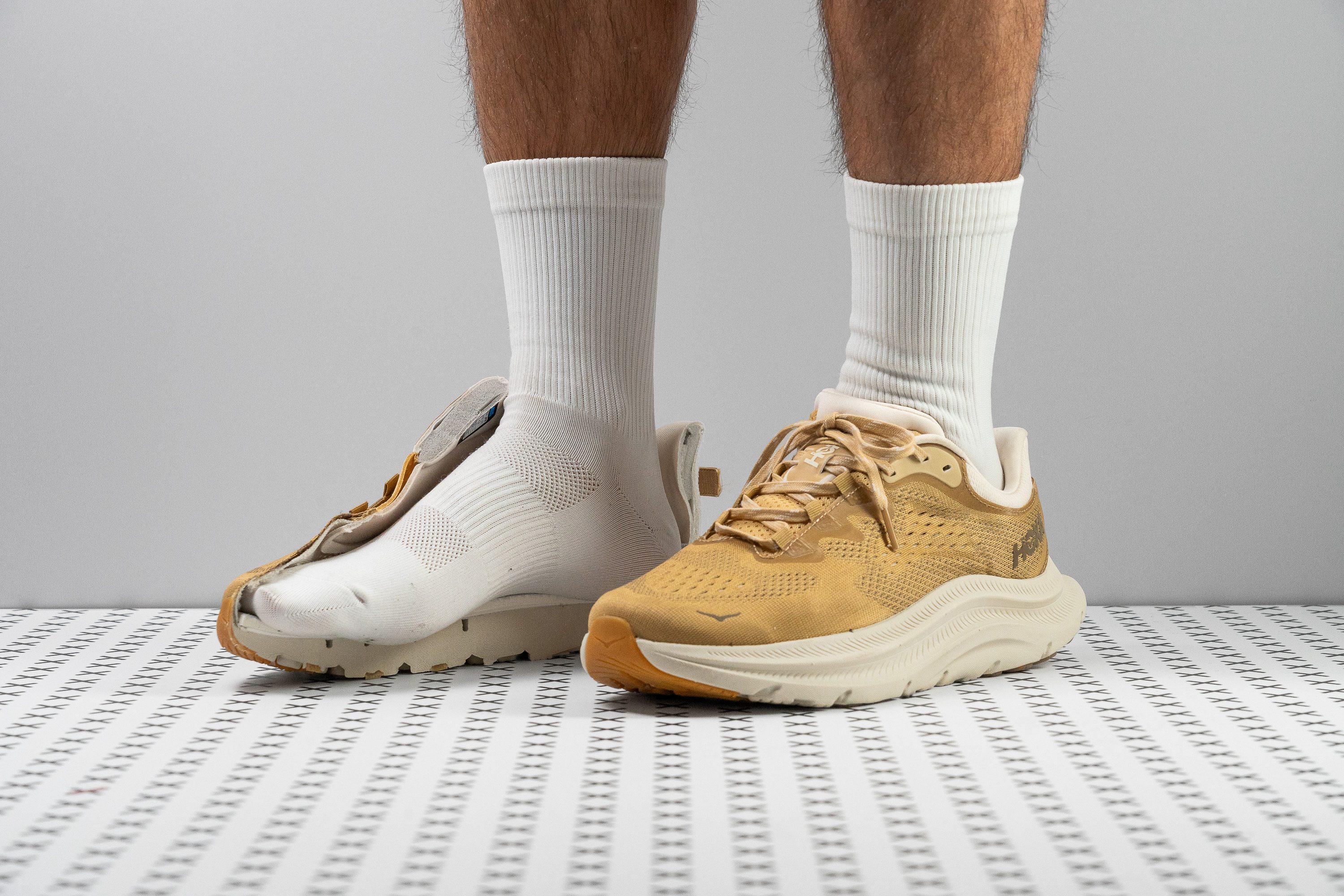Our verdict
- Top pick in best Shoes for gym and running
Pros
- Versatile for various activities
- Reduced weight from v1
- Comfortable fit
- Breathable, plush upper
- Secure lockdown with gusseted tongue
- Well-cushioned
- Fairly priced
- Super stable
Cons
- Bulky heel
- Narrow toebox
Audience verdict
- Top 12% most popular running shoes
Comparison
The most similar running shoes compared
+ + Add a shoe | |||||
|---|---|---|---|---|---|
| Audience score | 85 Good! | 79 Good! | 92 Superb! | 84 Good! | |
| Price | $140 | $70 | $125 | $135 | |
| Pace | Daily running | Daily running | Daily running | Daily runningTempo | |
| Shock absorption | Moderate | Moderate | High | Moderate | |
| Energy return | Low | Low | Moderate | Low | |
| Traction | Moderate | Moderate | Moderate | High | |
| Arch support | Neutral | Neutral | Neutral | Neutral | |
| Weight lab Weight brand | 10.5 oz / 298g 11.1 oz / 314g | 9.7 oz / 275g 9.7 oz / 275g | 10.1 oz / 285g 9.7 oz / 275g | 7.7 oz / 217g 7.6 oz / 215g | |
| Lightweight | ✗ | ✗ | ✗ | ✓ | |
| Drop lab Drop brand | 5.2 mm 5.0 mm | 7.8 mm 8.0 mm | 6.5 mm 6.0 mm | 5.9 mm 5.0 mm | |
| Strike pattern | Mid/forefoot | Mid/forefoot | Mid/forefoot | Mid/forefoot | |
| Size | True to size | True to size | True to size | Half size small | |
| Midsole softness | Balanced | Balanced | Soft | Soft | |
| Difference in midsole softness in cold | Normal | Small | Normal | Small | |
| Toebox durability | Decent | Bad | Decent | Bad | |
| Heel padding durability | Good | Good | Bad | Good | |
| Outsole durability | Good | Decent | Good | Decent | |
| Breathability | Moderate | Moderate | Moderate | Breathable | |
| Width / fit | Narrow | Medium | Narrow | Wide | |
| Toebox width | Narrow | Medium | Medium | Wide | |
| Stiffness | Stiff | Moderate | Moderate | Moderate | |
| Torsional rigidity | Moderate | Moderate | Stiff | Stiff | |
| Heel counter stiffness | Stiff | Stiff | Moderate | Moderate | |
| Rocker | ✗ | ✗ | ✓ | ✗ | |
| Heel lab Heel brand | 33.2 mm 30.0 mm | 31.2 mm 31.0 mm | 34.1 mm 38.0 mm | 32.8 mm 34.5 mm | |
| Forefoot lab Forefoot brand | 28.0 mm 25.0 mm | 23.4 mm 23.0 mm | 27.6 mm 32.0 mm | 26.9 mm 29.5 mm | |
| Widths available | Normal | NormalWideX-Wide | Normal | Normal | |
| Orthotic friendly | ✓ | ✓ | ✓ | ✓ | |
| Season | All seasons | All seasons | All seasons | SummerAll seasons | |
| Removable insole | ✓ | ✓ | ✓ | ✓ | |
| Ranking | #225 Bottom 39% | #320 Bottom 13% | #7 Top 2% | #241 Bottom 34% | |
| Popularity | #55 Top 15% | #88 Top 24% | #265 Bottom 28% | #126 Top 35% |
Who should buy
We think the Hoka Kawana 2 is a superb choice for:
- Runners seeking a versatile shoe for walks, weekend getaways, and maybe even gym sessions.
- Newcomers to the sport who want a multi-use shoe in case they decide against pursuing running as a primary activity.
- Enthusiasts of the original Kawana, looking for the same reliable package with enhanced features that improve on its predecessor.
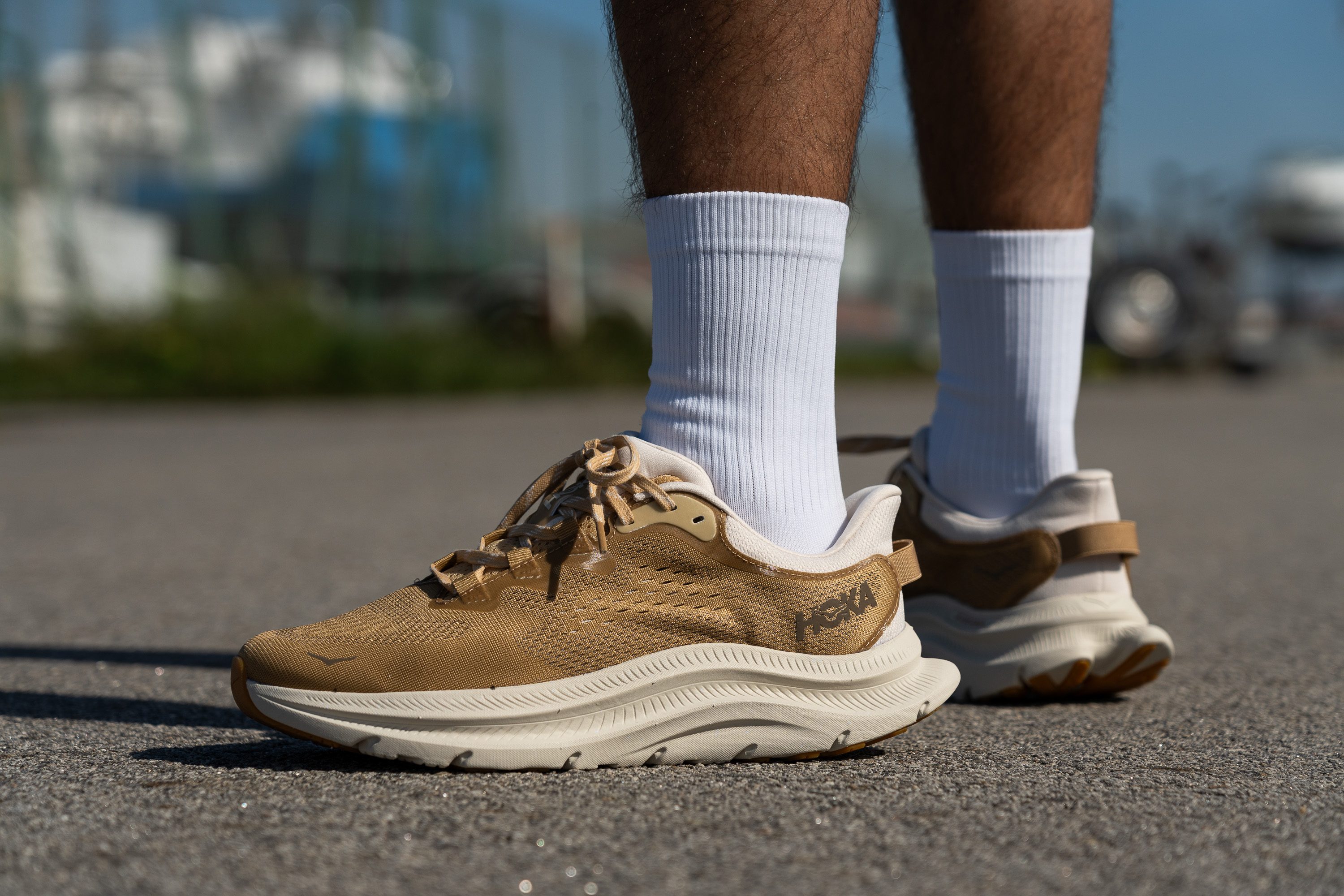
Who should NOT buy
We think the Hoka Kawana 2 might disappoint serious runners—it's a bit clunky and lacks the engaging ride of more specialized running shoes.
That's why we do not recommend it for any performance use, as there are way better options at similar price points. For instance, we believe the Hoka Clifton 9 or the ASICS Novablast 4 offer a superior running experience.
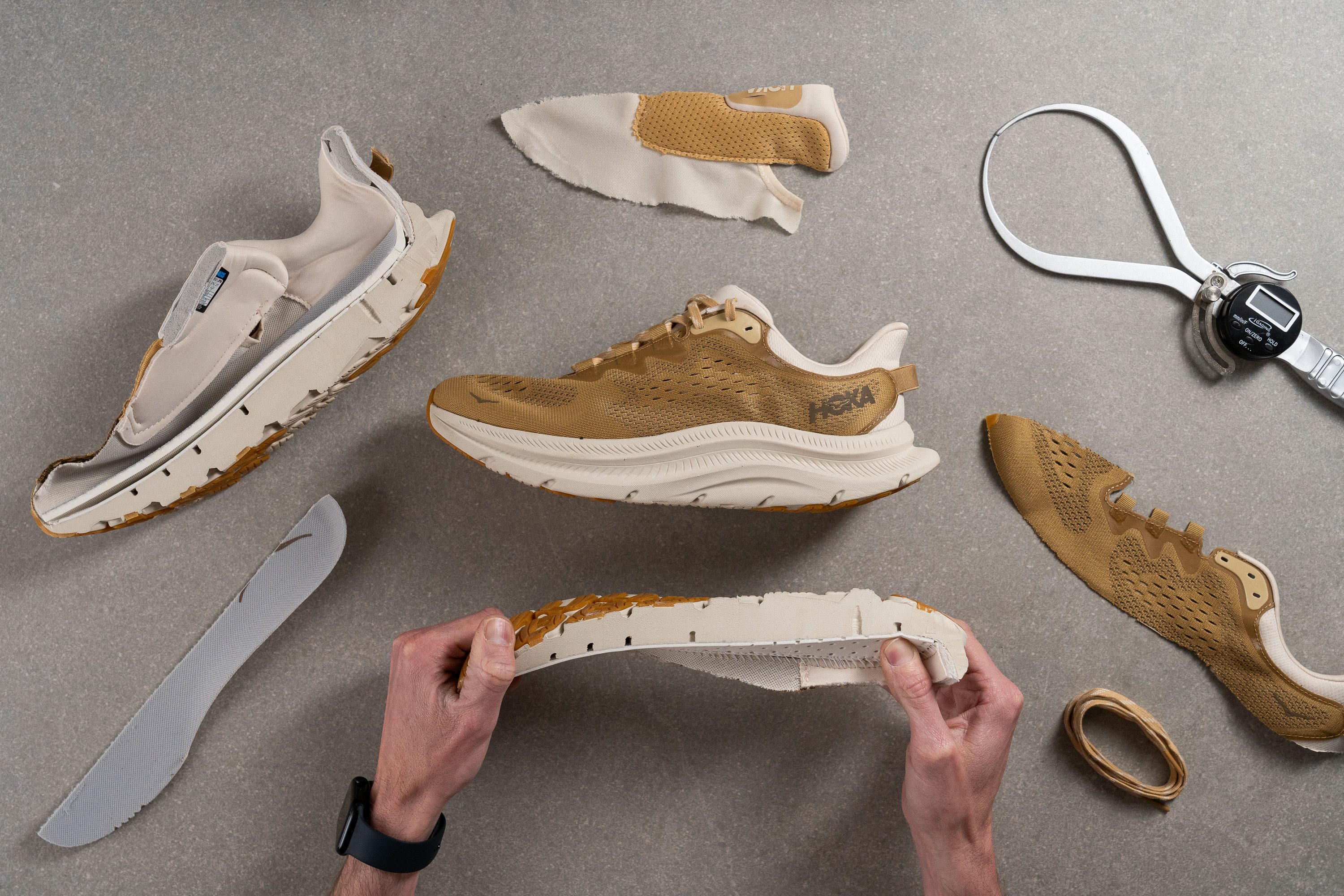
Furthermore, we've observed that while the Kawana 2 is stable for neutral runners, it's not suitable for those with real stability issues. Instead, we suggest the Hoka Gaviota 5, which is designed to provide the additional support needed by these runners and can double occasionally as a walking and gym shoe too.
Cushioning
Shock absorption
Impact dampening is definitely present in the Kawana 2. While 121 SA in the heel and 115 SA in the forefoot aren’t standout numbers, we found them very adequate for the kind of versatile use most buyers will give this shoe, blending everyday wear with occasional runs.

| Hoka Kawana 2 | 121 SA |
| Average | 129 SA |
Energy return
We were surprised to see the Kawana 2 hit 54.7% in the heel and 57.7% in the forefoot in our energy return test. These numbers are actually higher than what we measured in other Hoka models like the Gaviota 5.
| Hoka Kawana 2 | 54.7% |
| Average | 58.6% |
Heel stack
The Kawana 2 packs a substantial amount of foam, with our digital calipers measuring 33.2 mm.
This thickness is more than sufficient to support even the heaviest heel strikers, especially since the foam isn't overly compressive. Nonetheless, we'll delve deeper into this in a moment.
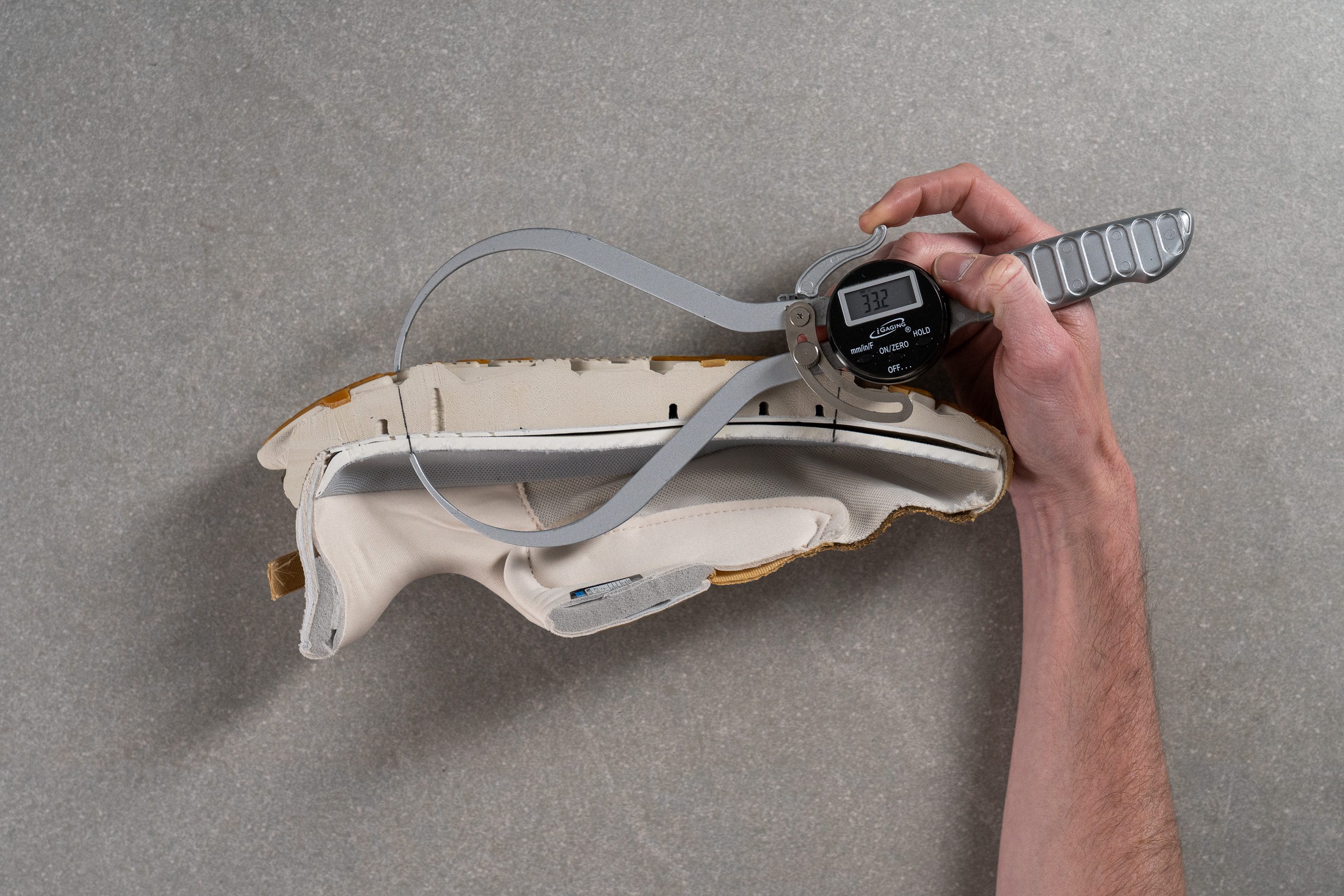
| Hoka Kawana 2 | 33.2 mm |
| Average | 34.8 mm |
Forefoot stack
The forefoot measures 28.0 mm, providing a cushioned ride that completely isolates you from feeling the ground. It truly embodies the generous, maximalist comfort Hoka is known for.

| Hoka Kawana 2 | 28.0 mm |
| Average | 26.2 mm |
Drop
The difference between the previous two measurements reveals a real 5.2-mm drop, closely aligning with the official 5.0-mm offset stated by the brand.
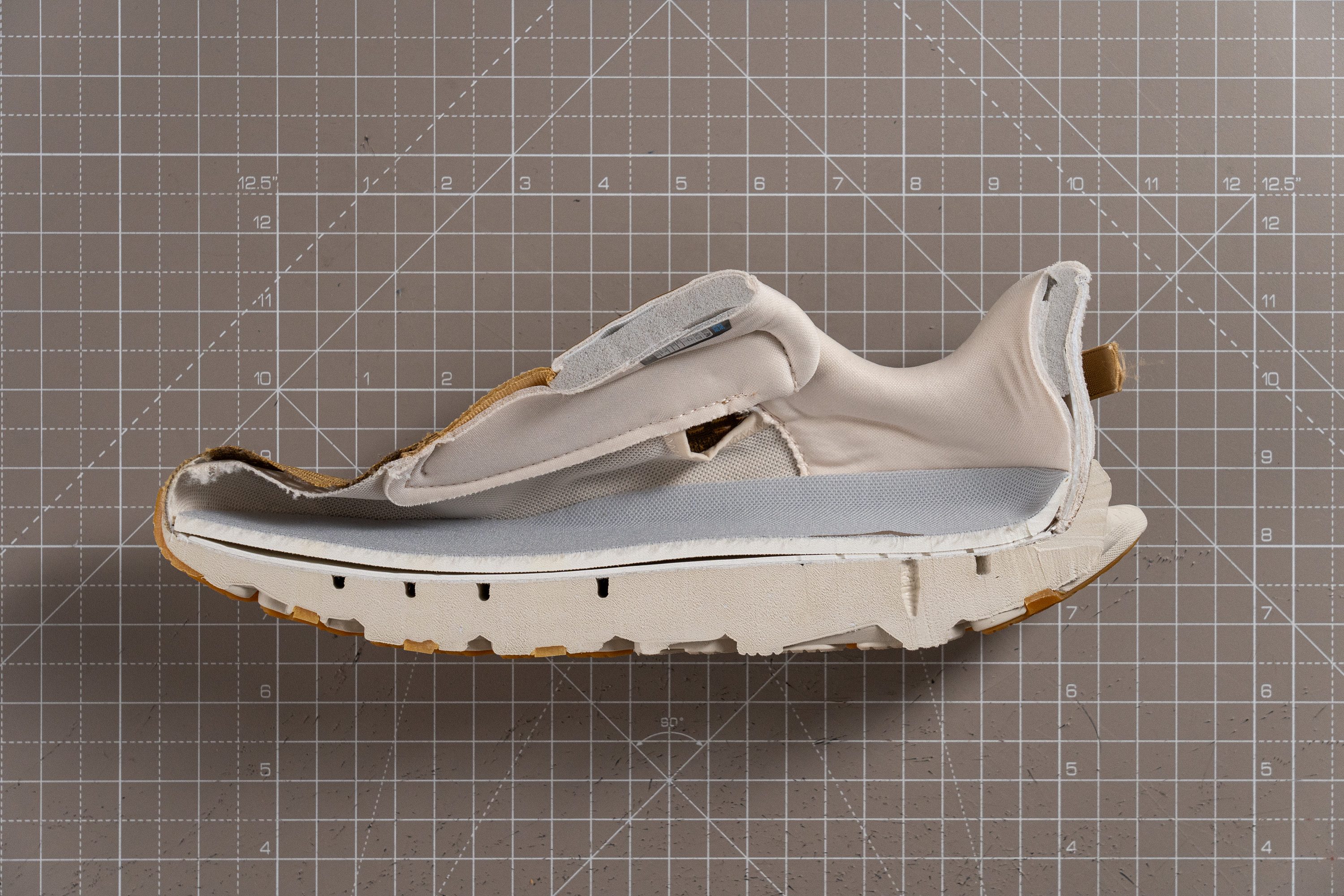
| Hoka Kawana 2 | 5.2 mm |
| Average | 8.6 mm |
Midsole softness
Moving to the midsole, we found the standard, regular CMEVA foam found in the previous version. It's not the supercritical EVA found in other Hokas.
While it doesn’t offer exceptional energy return, nor is it particularly soft or bouncy, it provides reliable performance with a softness score of 21.1 HA.
This level of softness is actually ideal for a shoe used not only for running but also for walking and gym activities, where an overly plush midsole is not ideal.
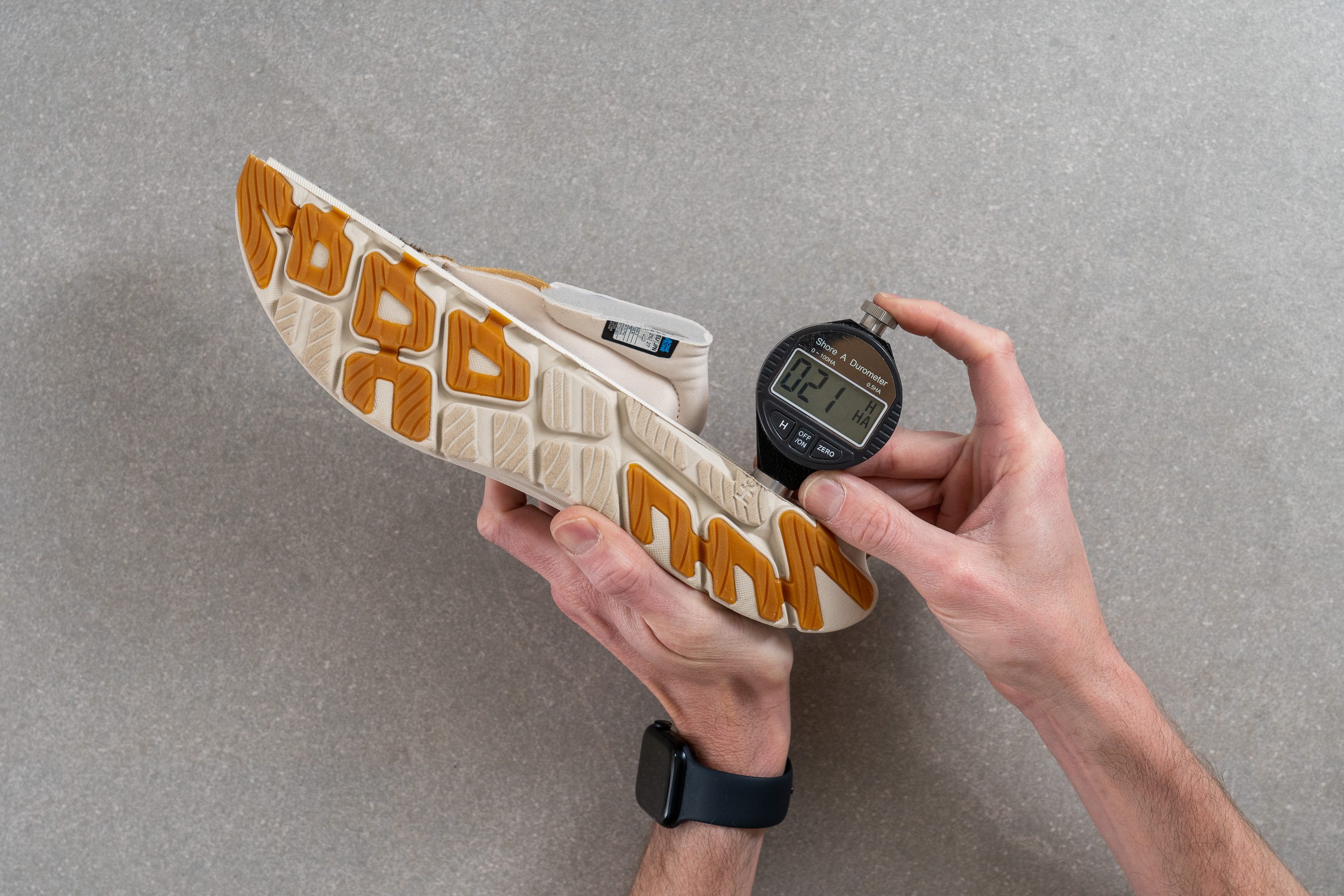
| Hoka Kawana 2 | 21.1 HA |
| Average | 20.4 HA |
Size and fit
Size
Hoka Kawana 2 fits true to size (68 votes).
Width / Fit
Using our caliper, we measured the Kawana 2’s width at 91.1 mm—a noticeably narrow result compared to our current lab average.
Our analysis indicates two key takeaways. First, this measurement aligns with Hoka’s reputation for crafting snug-fitting uppers. Second, this shoe is particularly suited for runners with narrow or moderately narrow feet, offering a secure yet precise fit for these foot shapes.
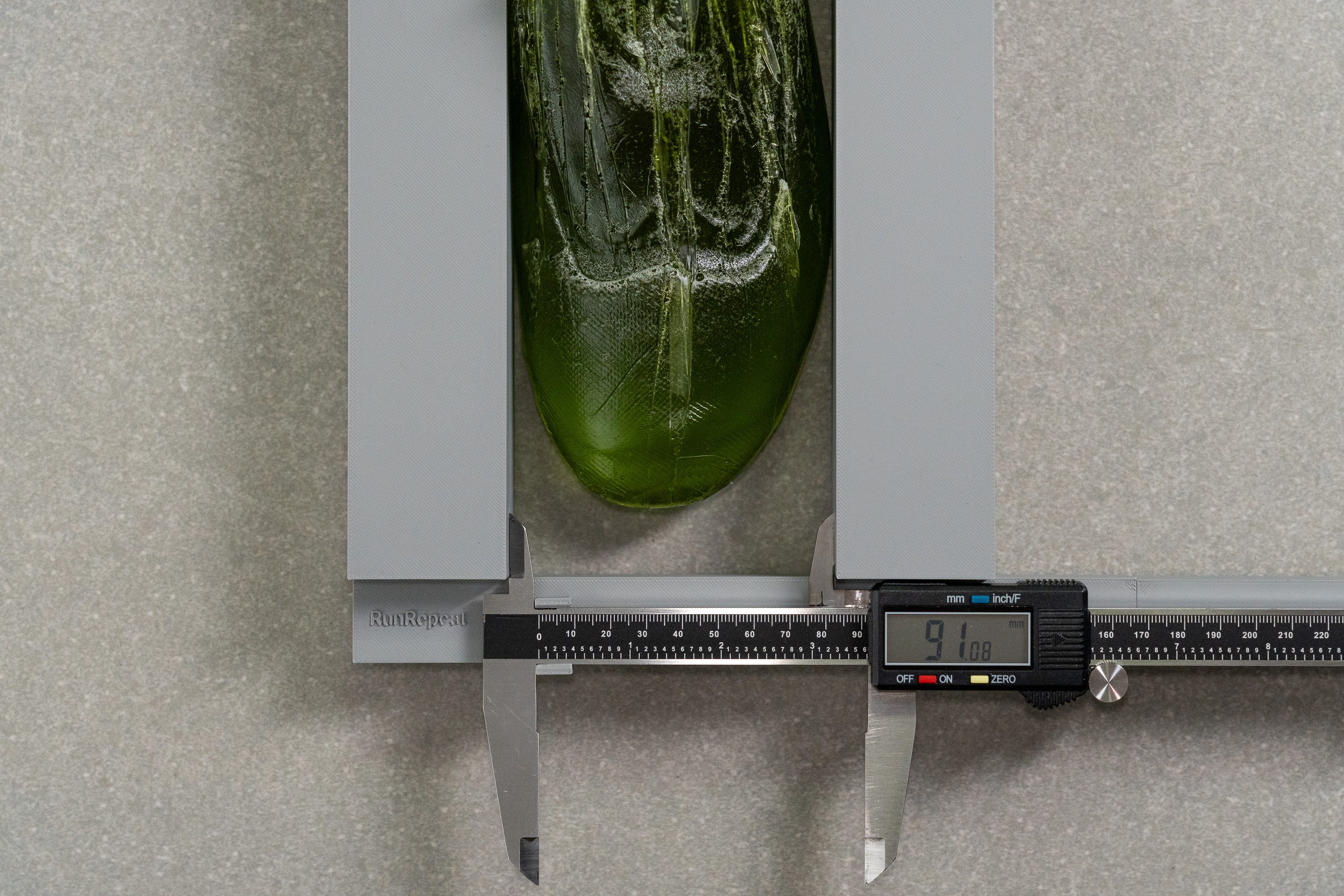
| Hoka Kawana 2 | 91.1 mm |
| Average | 95.1 mm |
Toebox width
We always take a second measurement in the big toe area to get a clearer understanding and comparison of the fit.
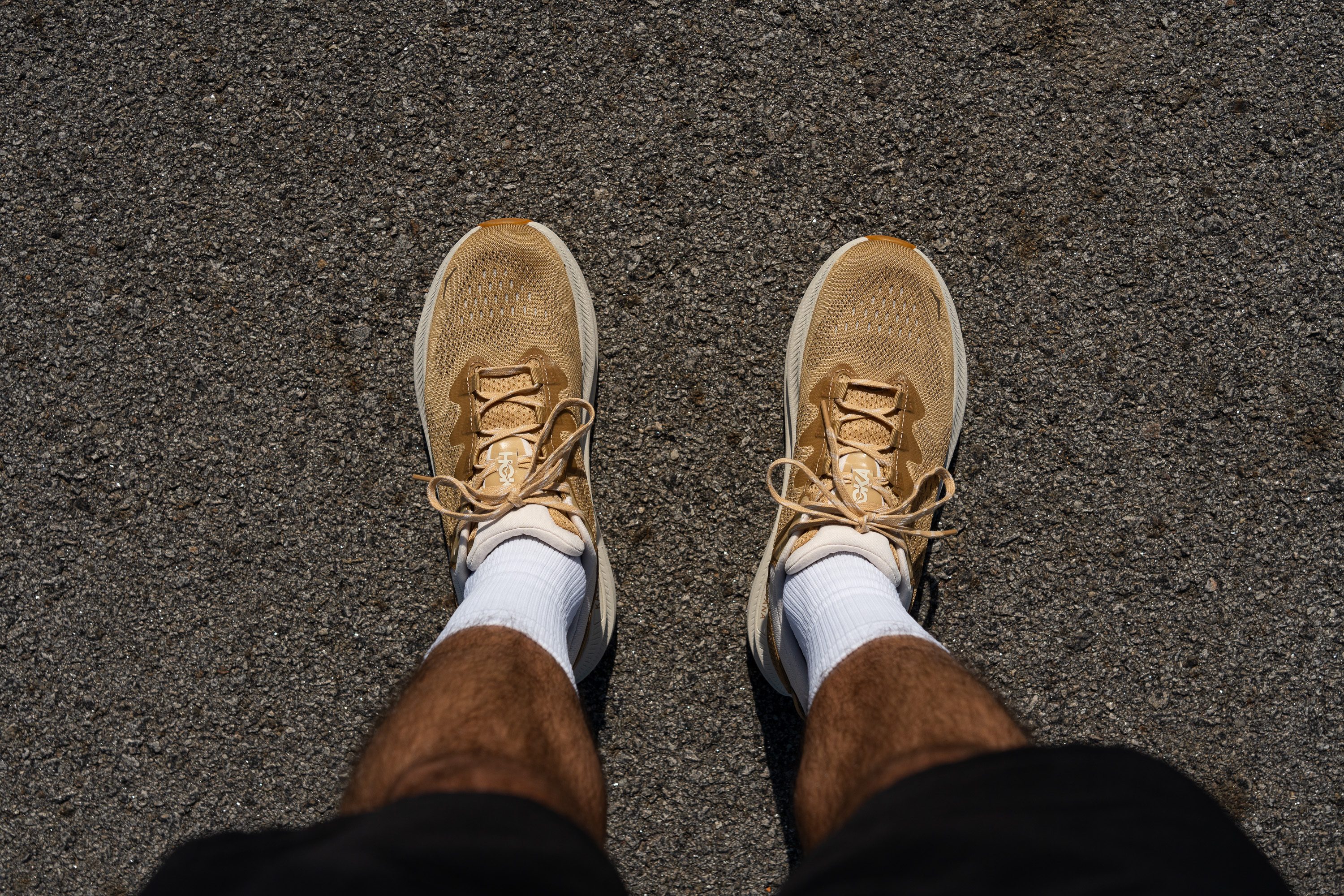
With a measurement of 70.2 mm, the toebox features a strong taper. Based on this, again, we wouldn't recommend this model for those with wide feet.
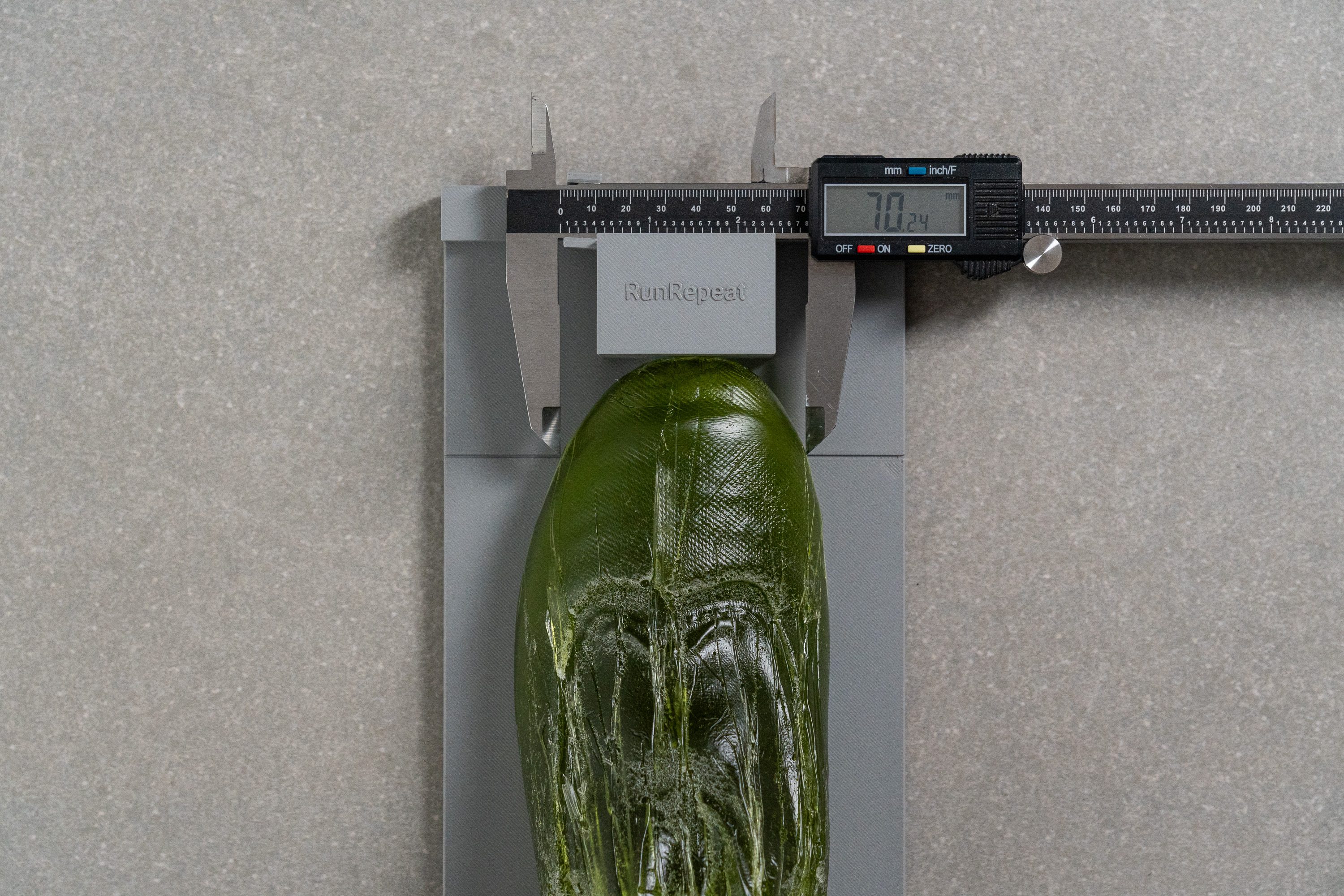
| Hoka Kawana 2 | 70.2 mm |
| Average | 73.3 mm |
Toebox height
On the flip side, what Hoka reduced in width, it compensated for in height—measuring an impressive 28.9 mm, well above average. This provides ample space for vertical toe movement.
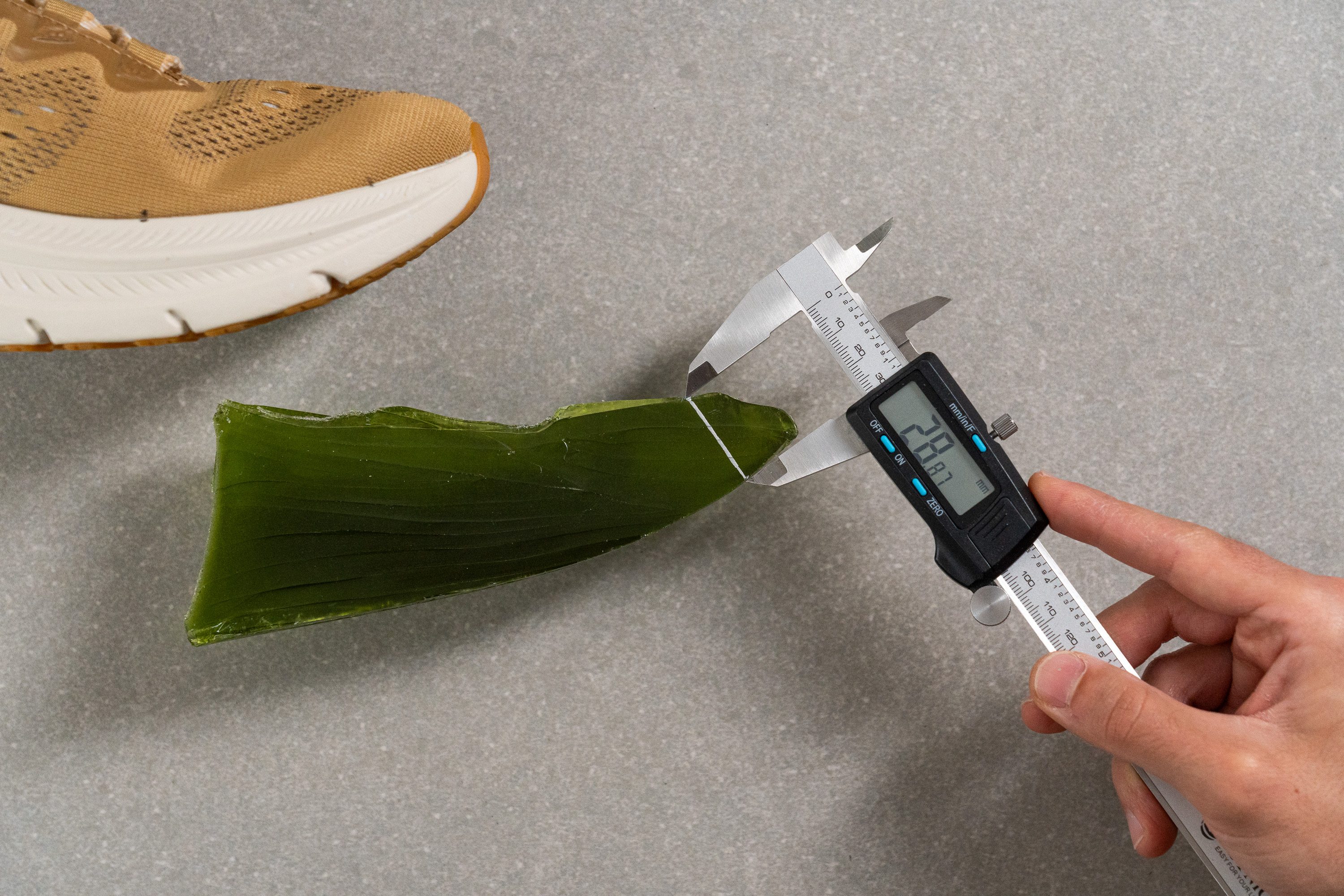
| Hoka Kawana 2 | 28.9 mm |
| Average | 27.1 mm |
Traction / Grip
Traction test
We tested the Hoka Kawana 2 under wet conditions and found a 0.40 score, which places it at the lower edge of good grip for rainy days. The shoe’s performance on dry pavement feels more secure, delivering a steady ride for everyday runs.
This is another reason why we think that this shoe is more suited to relaxed outings or easy jogs, where weather extremes are less likely to be an issue.
| Hoka Kawana 2 | 0.40 |
| Average | 0.48 |
Outsole design
The outsole stays close to last year’s design, with only minor updates. We found rubber placed only in high-wear zones, and that may be a concern for some. In fact, runners who prefer max coverage might find this setup underwhelming.
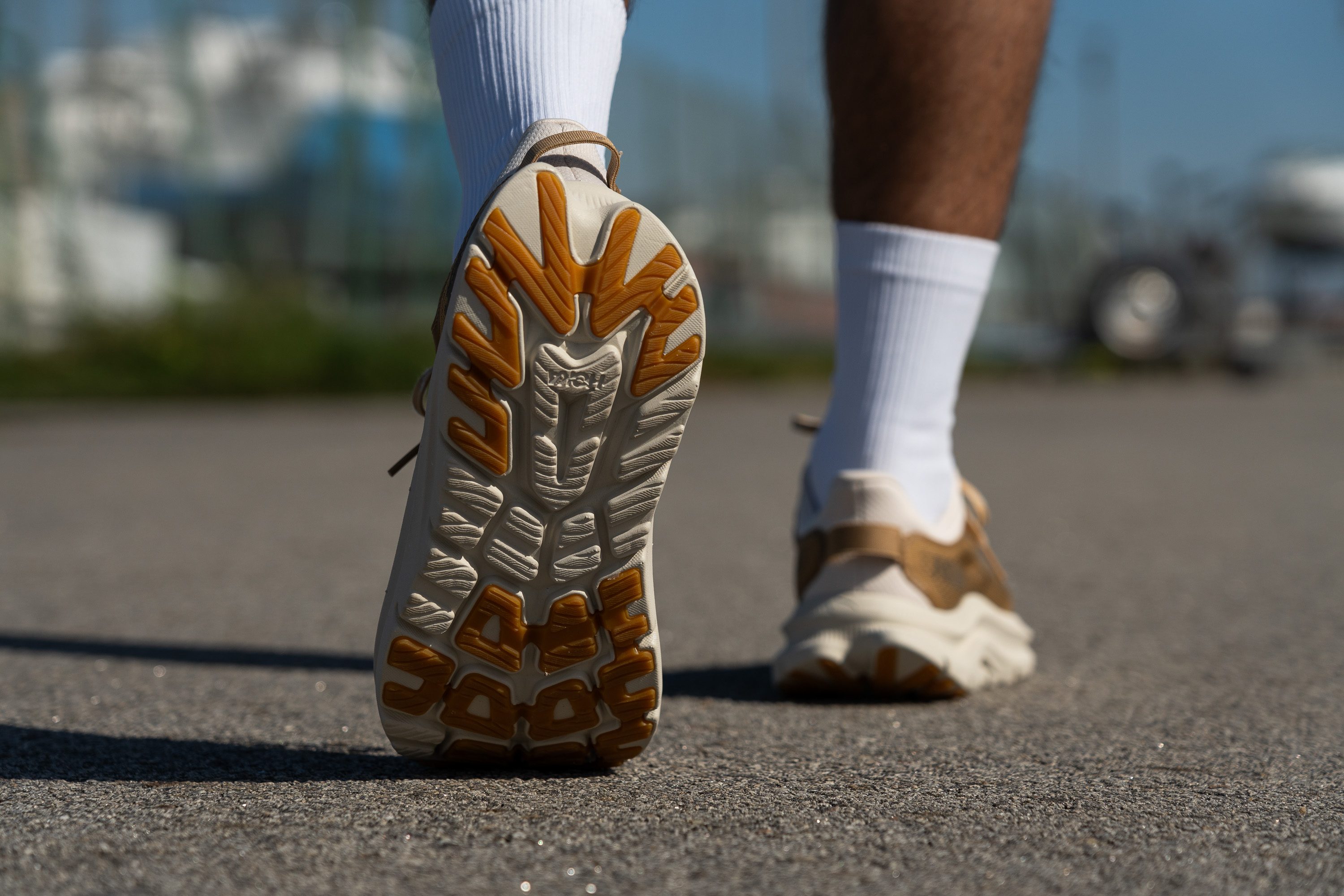
Flexibility / Stiffness
Continuing with the generally balanced approach that characterizes many aspects of the Kawana's design, our 30-degree bend test yielded similar results.
With a measurement of just 17.4N, it qualifies as a comfy shoe with average stiffness—though we wish it had a bit more flex.

| Hoka Kawana 2 | 17.4N |
| Average | 15.3N |
Weight
The outsole and midsole have remained largely the same, but the redesigned upper has helped keep the Kawana 2 just under 11 oz and slightly below the 300g mark. While it's not exceptionally lightweight and is undeniably on the heavier side, we recognize that this shoe is designed for occasional runs and everyday wear, where comfort is prioritized over lightness.
That said, we believe that Hoka has the potential to further reduce the weight of the Kawana. We are hopeful that they will aim to bring it below 10 ounces in future iterations. That would be amazing for running!
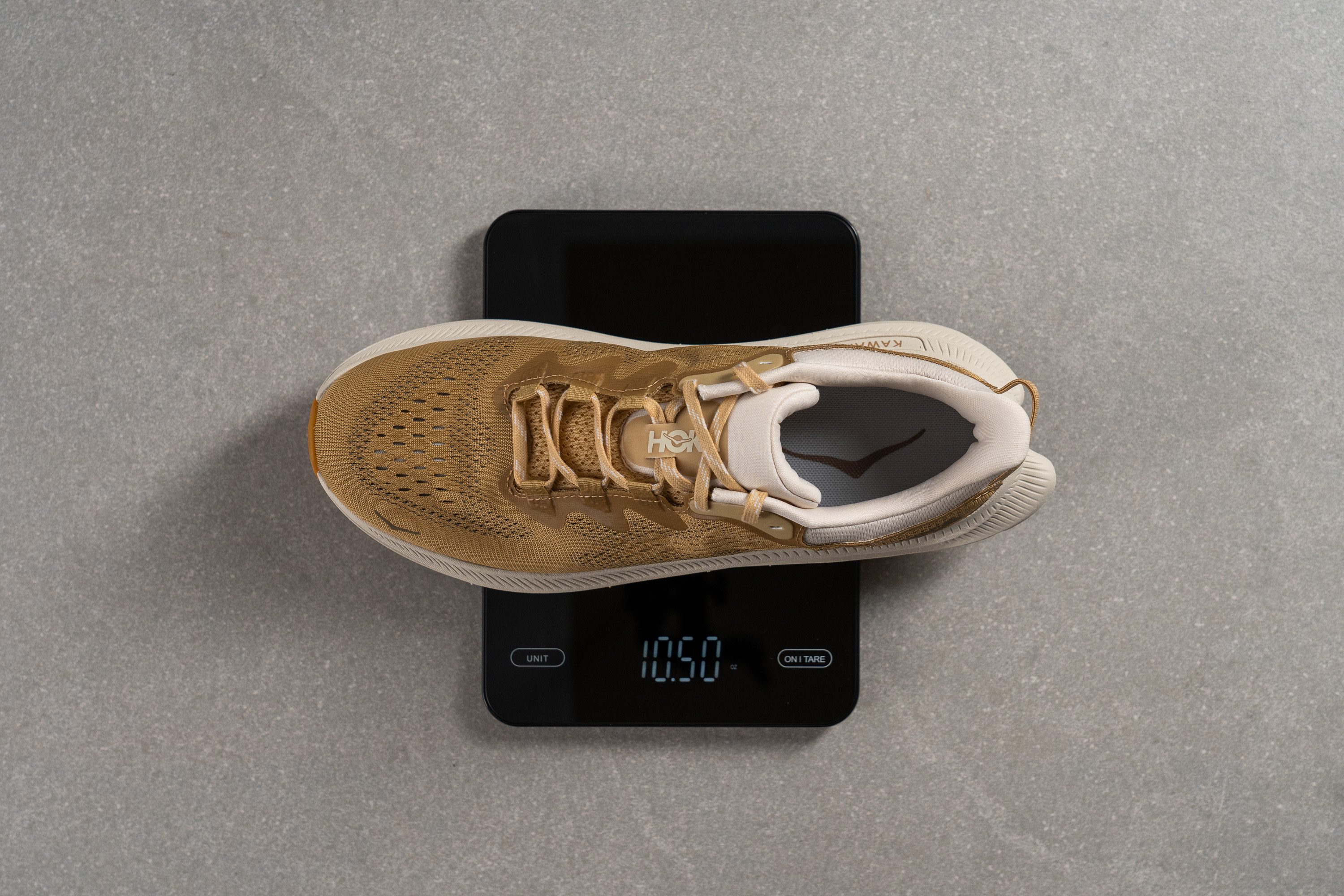
| Hoka Kawana 2 | 10.5 oz (298g) |
| Average | 9.3 oz (264g) |
Breathability
Upon our initial inspection of the Kawana right out of the box, we immediately noticed numerous ventilation holes that should deliver good breathability. But instead of speculating further, we jumped right into the lab tests.
First up, we filled the shoe with smoke to check if those ventilation holes were functional, especially since they appeared to have a white layer underneath that might obstruct airflow. That didn't happened, earning the Kawana 2 a solid 4/5 rating from us.
Using a light, we discovered that excellent ventilation isn't confined to the toebox—it extends to the midfoot area as well. This is especially good news for those warm summer walks or runs.
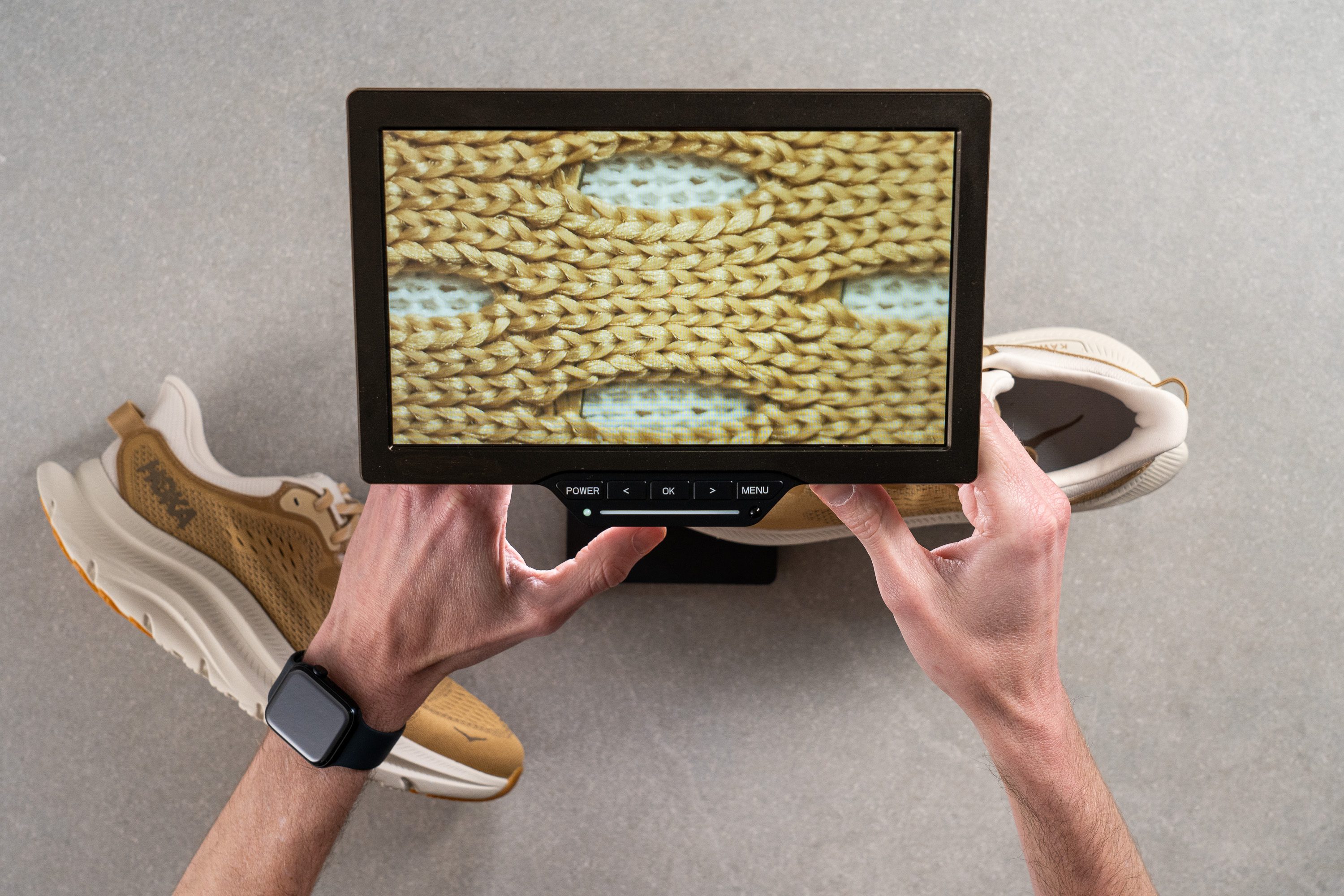
After these initial tests, we zoomed in on those ventilation holes with a microscope to get a closer look.
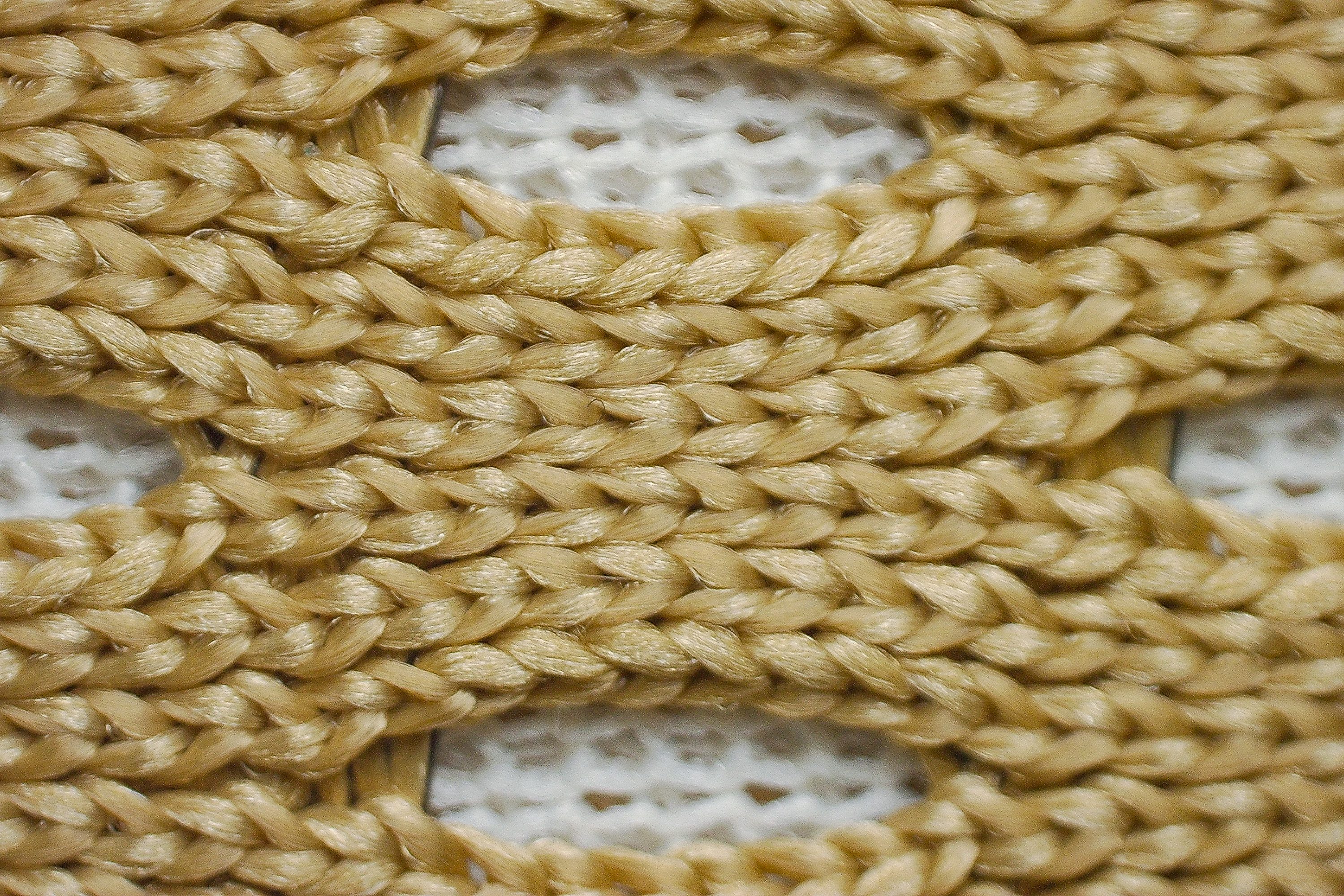
Under the microscope, we uncovered the secret to the Kawana's good performance. Despite the presence of a second layer, it includes thousands of microperforations—a small but significant detail that makes a huge difference in breathability. Simply awesome.
Finally, we examined the dual-layer engineered mesh and found that it's not very stretchy. We also noted a remarkably thick tongue and heel padding, which we'll delve into more deeply later in this lab review.
| Hoka Kawana 2 | 4 |
| Average | 3.7 |
Stability
Lateral stability test
Thanks to its well-balanced midsole geometry and a 5-mm drop, the Kawana 2 provides stability that exceeded our expectations for a shoe designed for neutral runners.
We found that the large midsole sidewalls, especially in the midfoot area, and the robust lateral support contributed significantly to a stable ride during our runs.
Torsional rigidity
In terms of rigidity, the shoe strikes a balance, feeling neither too stiff nor too flexible. This is ideal because the Kawana 2 is designed to perform well across a variety of activities.
From our manual assessment, we rated its rigidity at a solid 3/5.
| Hoka Kawana 2 | 3 |
| Average | 3.5 |
Heel counter stiffness
And what about the heel counter? It plays a significant role in the nice stability we experienced, earning a 4/5 in our tests—a slight change from last model's 3/5 rating. Although for a shoe aimed at versatility, we generally prefer a softer heel...
However, there's a twist. Hoka has cleverly added a looot of padding to the heel counter, and despite its stiffness, it's incredibly comfortable. This was a smart move!
| Hoka Kawana 2 | 4 |
| Average | 2.9 |
Midsole width - forefoot
Returning to the midsole, we shifted our focus to its dimensions. In the forefoot, the Kawana 2 maintains a fairly standard width (115.2 mm) with no sole flare or distinctive features to note.
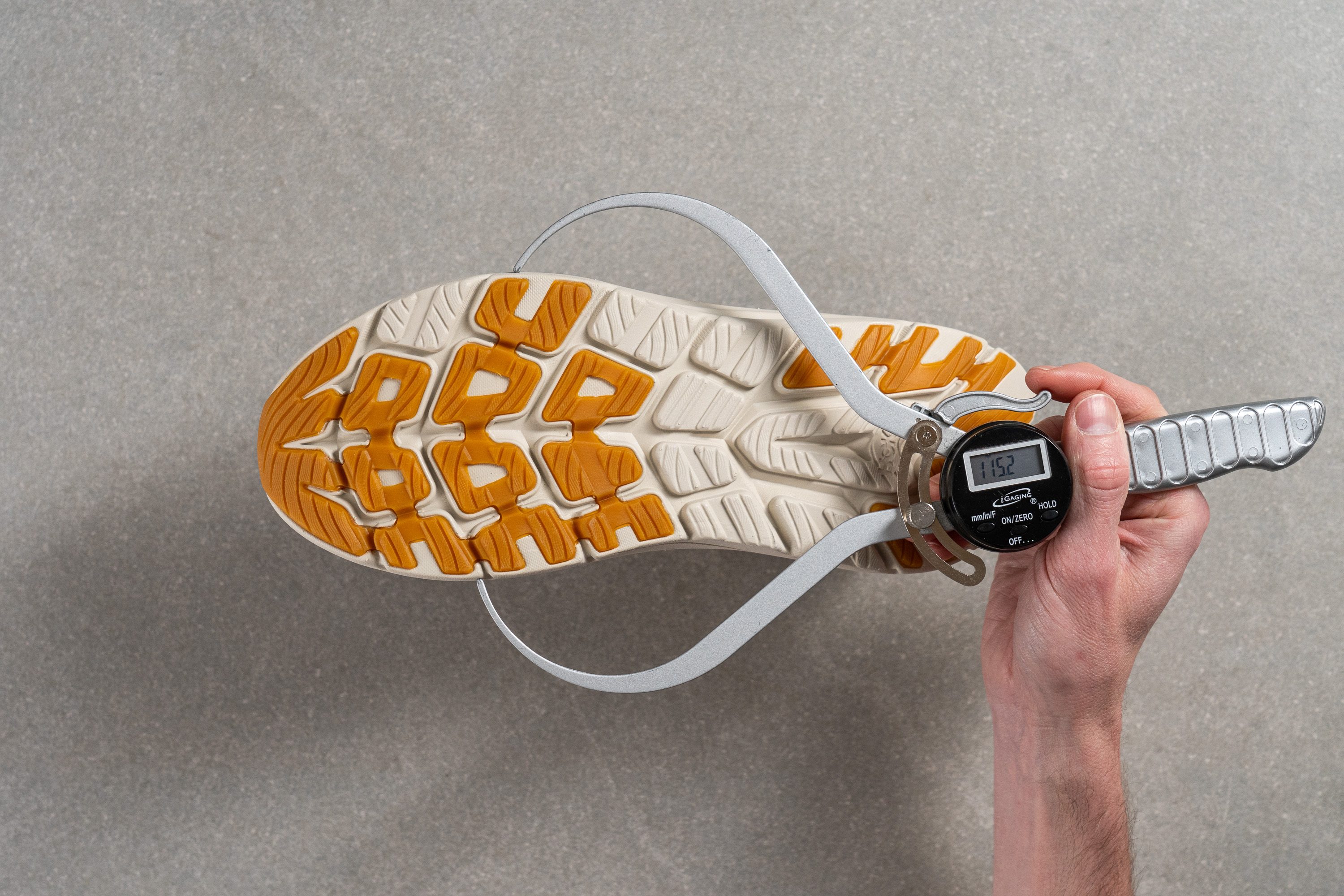
| Hoka Kawana 2 | 115.2 mm |
| Average | 114.4 mm |
Midsole width - heel
However, the heel stands out significantly from the average shoe with its notably wider 98.9 mm width.
This feature significantly enhances the shoe's stability, although it does come with the tradeoff of added bulkiness, making the shoe feel somewhat cumbersome for those accustomed to narrower shoes. If you're one of those, a more versatile option for walking and running, such as the Adidas Ultraboost, might be a better choice.
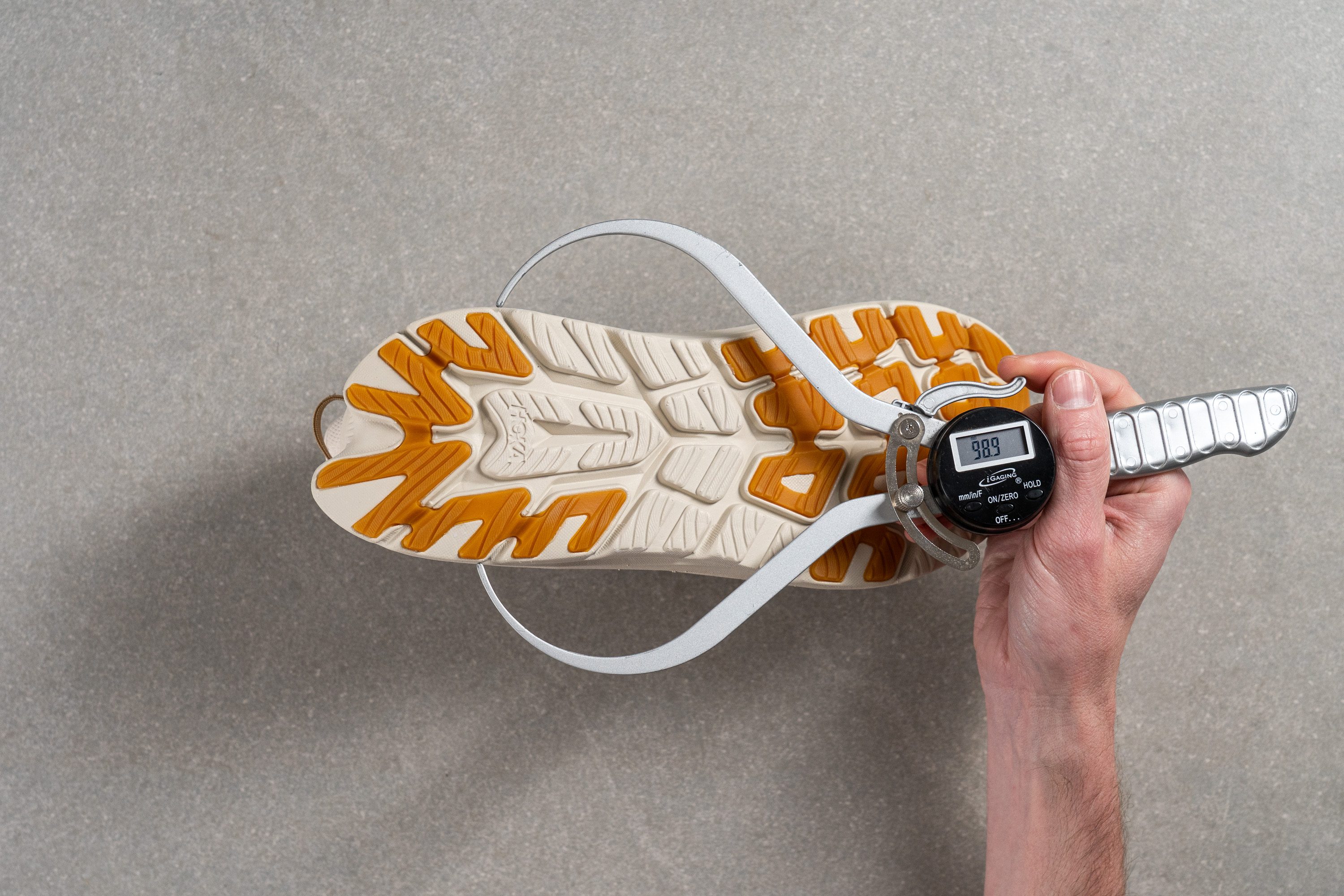
| Hoka Kawana 2 | 98.9 mm |
| Average | 90.7 mm |
Durability
Toebox durability
Off to a strong start, we were keen to see how the upper of the Kawana 2 would hold up against our Dremel test, knowing that airy uppers typically face challenges in this area.
Surprisingly, the outcome was impressive. The top layer of the Kawana 2 resisted remarkably well, and the bottom layer remained completely intact, ready to offer additional protection if needed. This performance earned the Kawana 2 a solid 3/5 on our durability scale.

| Hoka Kawana 2 | 3 |
| Average | 2.6 |
Heel padding durability
Our second Dremel test put the heel padding to the same rigorous challenge as before: running at 5K RPM under a force of 3.2N.
The results were even more impressive, earning a strong 4/5 from our lab team. This test clearly demonstrated that we can be confident about the heel's resistance to wear in this critical area. The durability here should alleviate any concerns about potential wear and tear.
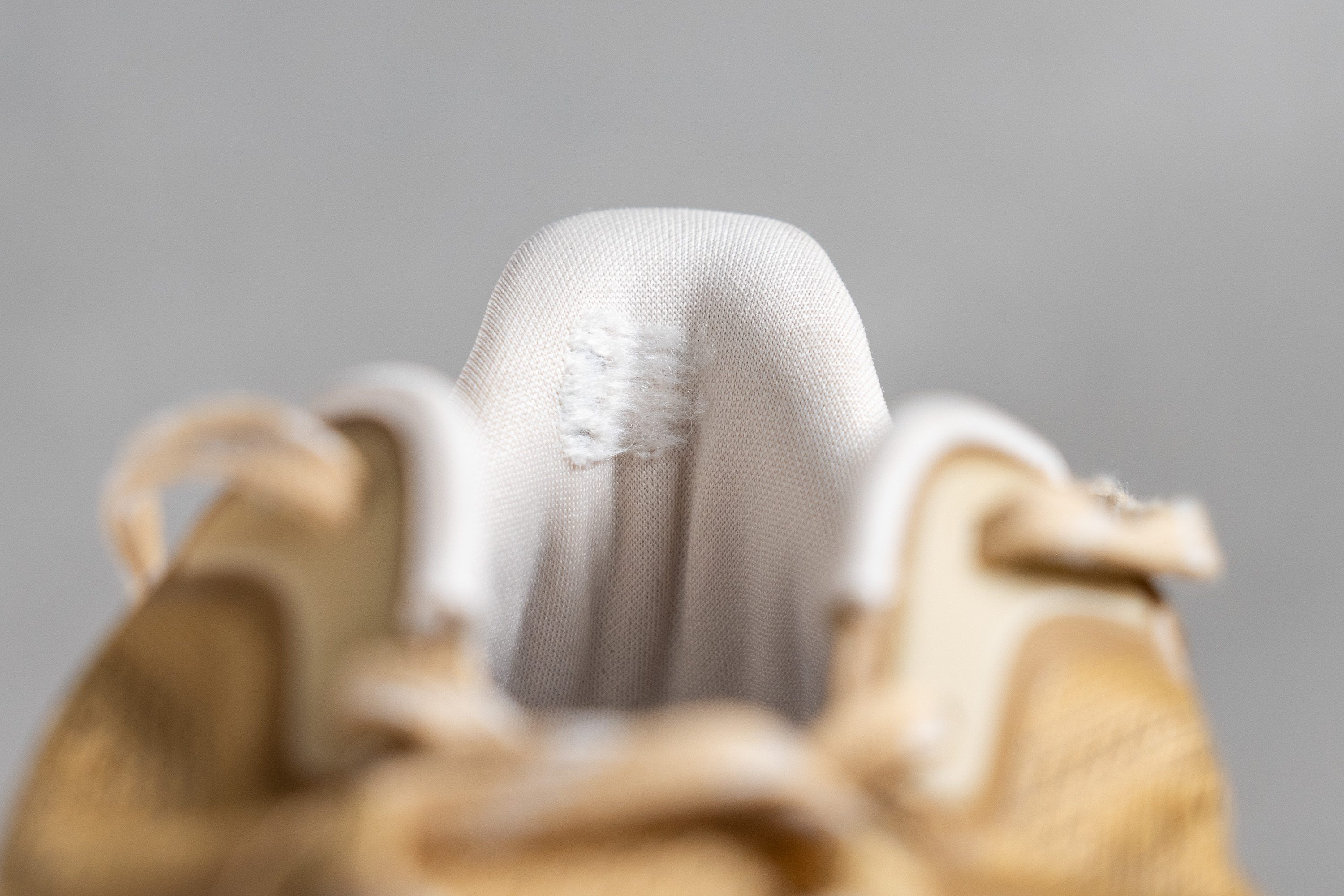
| Hoka Kawana 2 | 4 |
| Average | 3.4 |
Outsole durability
How durable is the rubber compound used by Hoka? To find out, we fired up the Dremel to twice the RPM for our third and final test with it.
The results were impressive. After completing the test, we observed that the indentation left by the tool was merely 0.6 mm—this performance surpasses that of most running shoes we've tested, showcasing exceptional durability.

| Hoka Kawana 2 | 0.6 mm |
| Average | 1.1 mm |
Outsole thickness
The Kawana 2 features a streamlined, 2.5-mm thick rubber outsole, which helps reduce the shoe's overall weight.
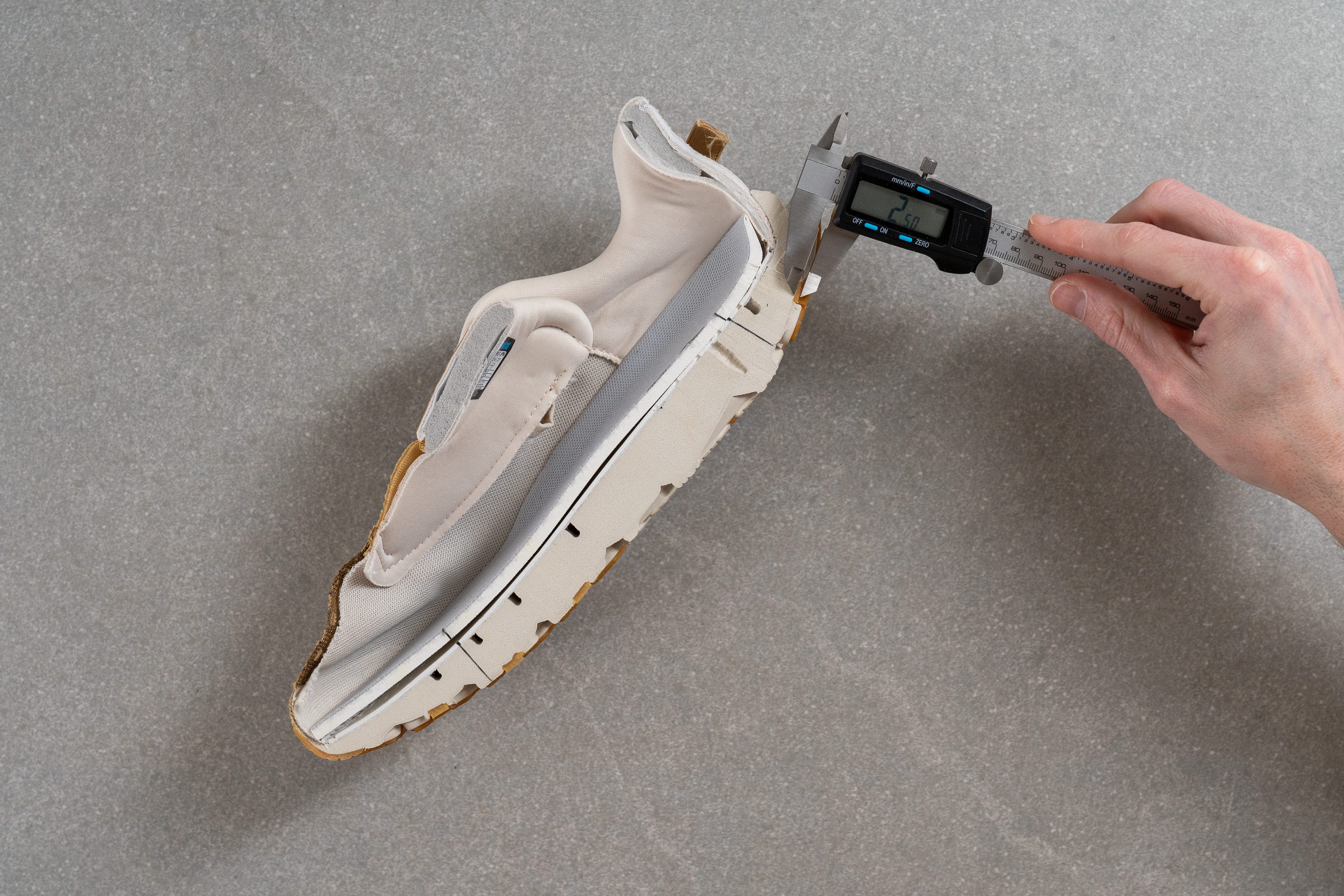
| Hoka Kawana 2 | 2.5 mm |
| Average | 3.2 mm |
Misc
Insole thickness
The insole is made from comfortable EVA foam and boasts a significant thickness of 5.0 mm, enhancing the comfort noticeably during our runs and walks.
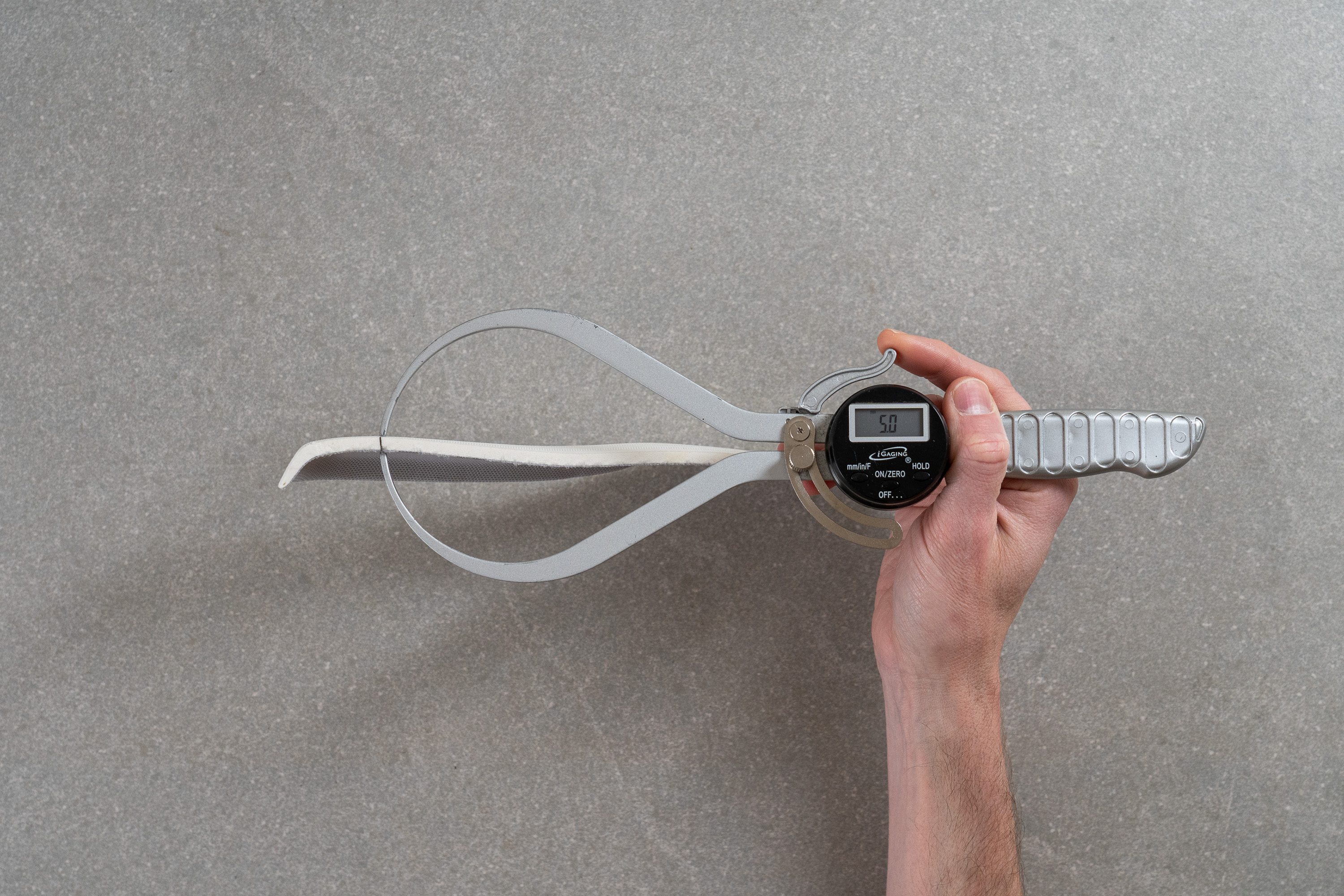
| Hoka Kawana 2 | 5.0 mm |
| Average | 4.5 mm |
Removable insole
The insole is removable since it's not glued down, offering flexibility for those who prefer custom footbeds. However, it's designed with contoured edges from the midfoot to the heel, enhancing foot lockdown. Swapping it out might result in a downgrade for some.

| Hoka Kawana 2 | Yes |
Midsole softness in cold (%)
Given that it's just EVA, we didn't expect stellar performance in cold temperatures.
To verify this, we placed the shoe in the freezer for 20 minutes and then retested it with our durometer. The result showed a 29.6% increase to 27.4 HA, which is quite decent!

| Hoka Kawana 2 | 30% |
| Average | 24% |
Reflective elements
We always appreciate it when shoes include hi-vis stuff, and we found that the Kawana 2 delivers on that!
| Hoka Kawana 2 | Yes |
Tongue padding
The tongue padding at 13.9 mm blew our minds. We've encountered some ultra-cushy tongues in our lab across these years, but this one surpasses all expectations—it's a DREAM for anyone who appreciates a soft pressure on the instep.
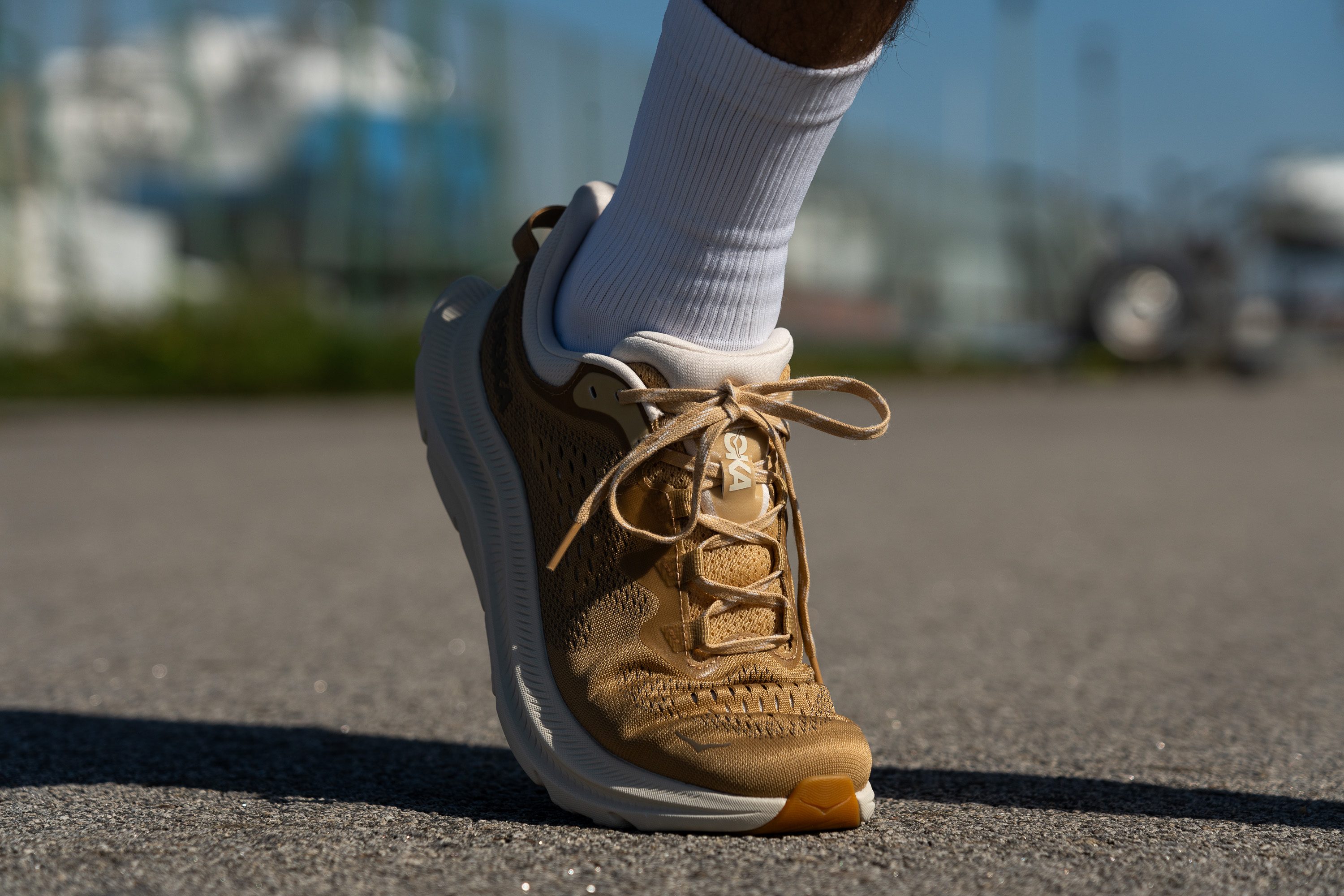
However, more padding isn't always a plus. The thicker tongue does add some weight to the shoe, and for those with larger feet overall, it can lead to excessive pressure. From our perspective, a padding around 8 mm or 10 mm might offer a more balanced, universal approach.
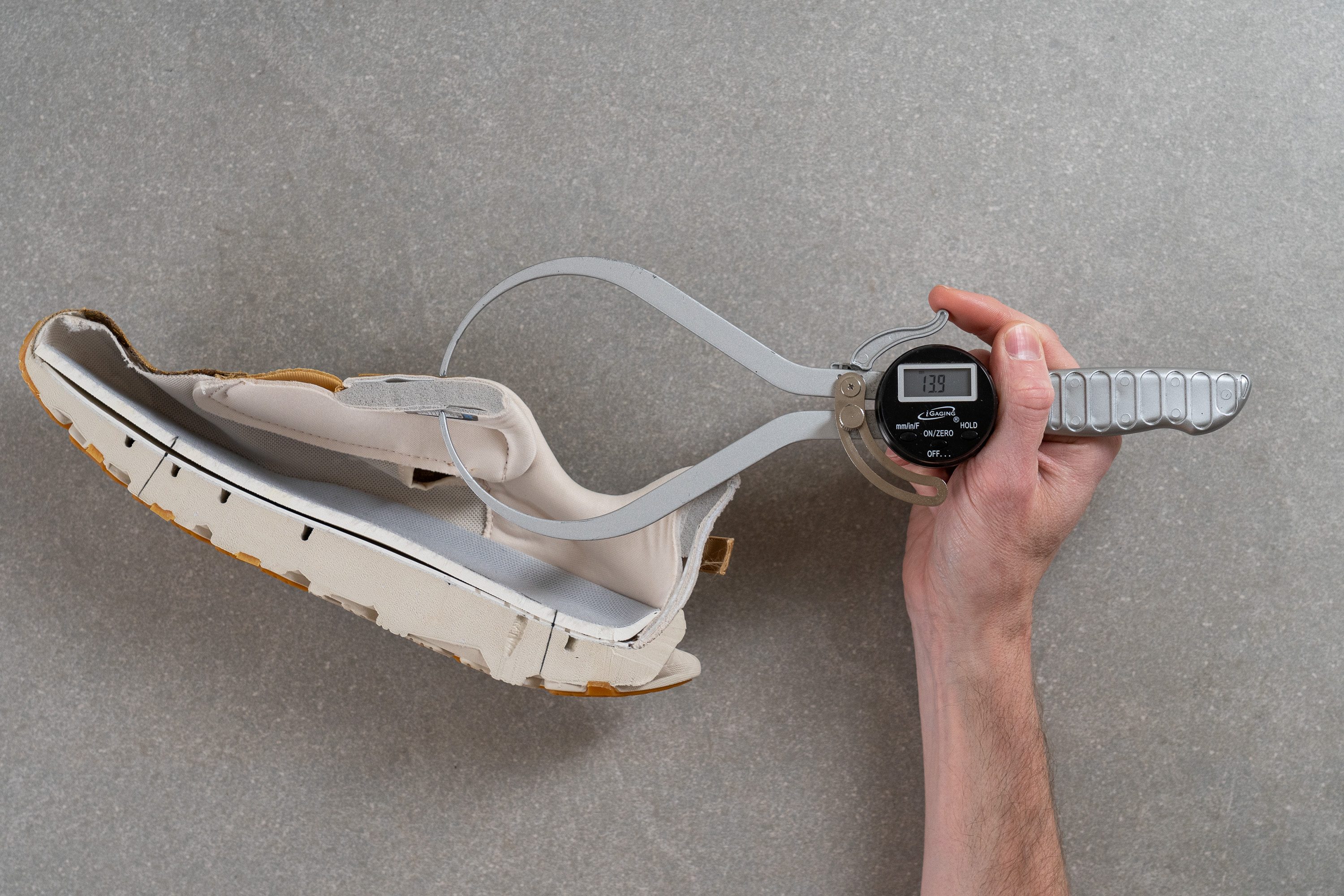
| Hoka Kawana 2 | 13.9 mm |
| Average | 5.8 mm |
Tongue: gusset type
The tongue is now fully gusseted, a notable shift from the previous Kawana's semi-gusseted design. We've found that both styles are fantastic as they effectively prevent the tongue from shifting sideways, ensuring a stable and snug fit.
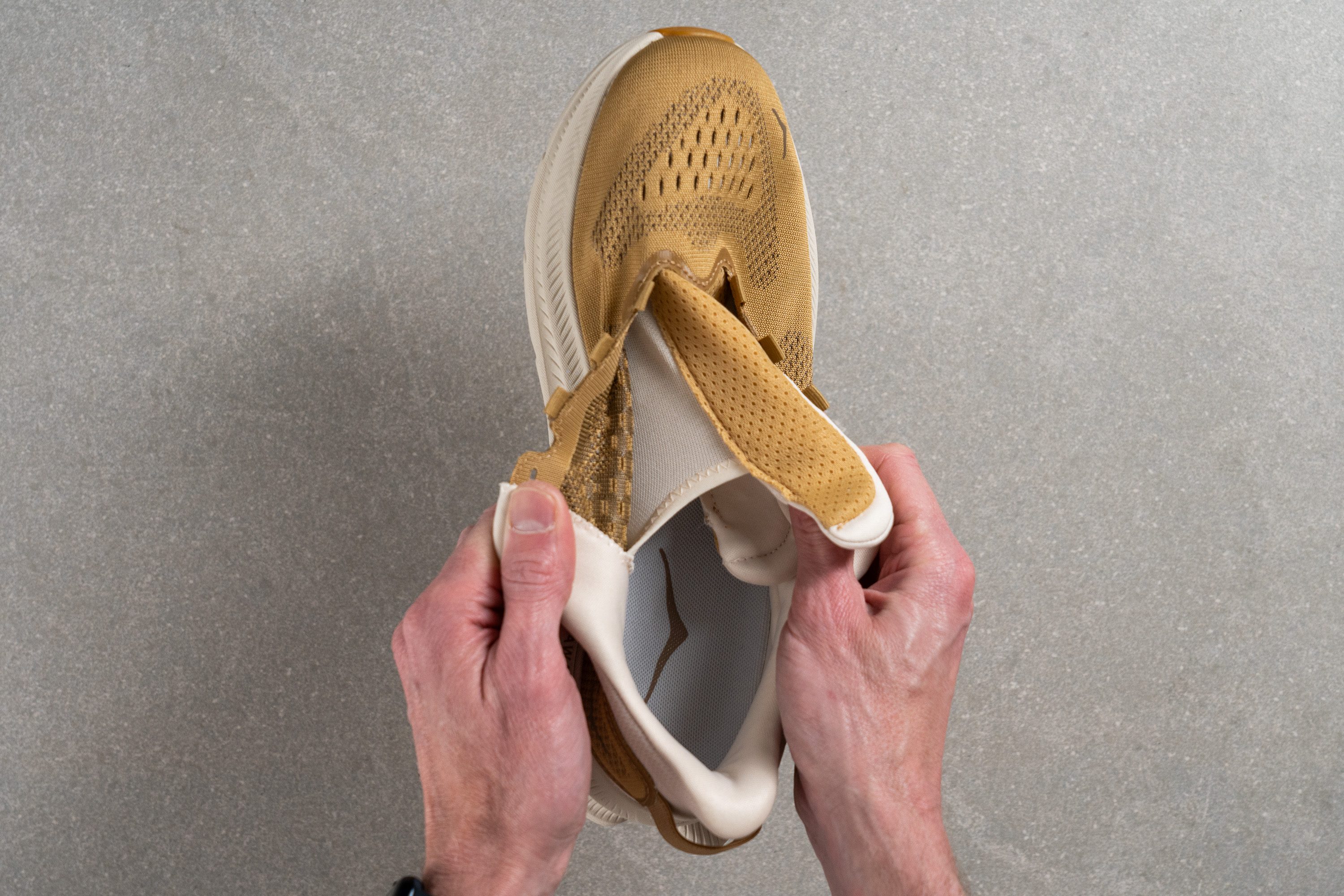
| Hoka Kawana 2 | Both sides (full) |
Heel tab
The heel of the shoe features a finger-loop, horizontal heel tab that is seamlessly integrated into its design.

It's a welcome bonus, especially since the original Kawana lacked this feature. We found that this tab not only enhances the shoe's aesthetics but also makes it more functional, providing an easier grip for slipping the shoe on and off effortlessly.
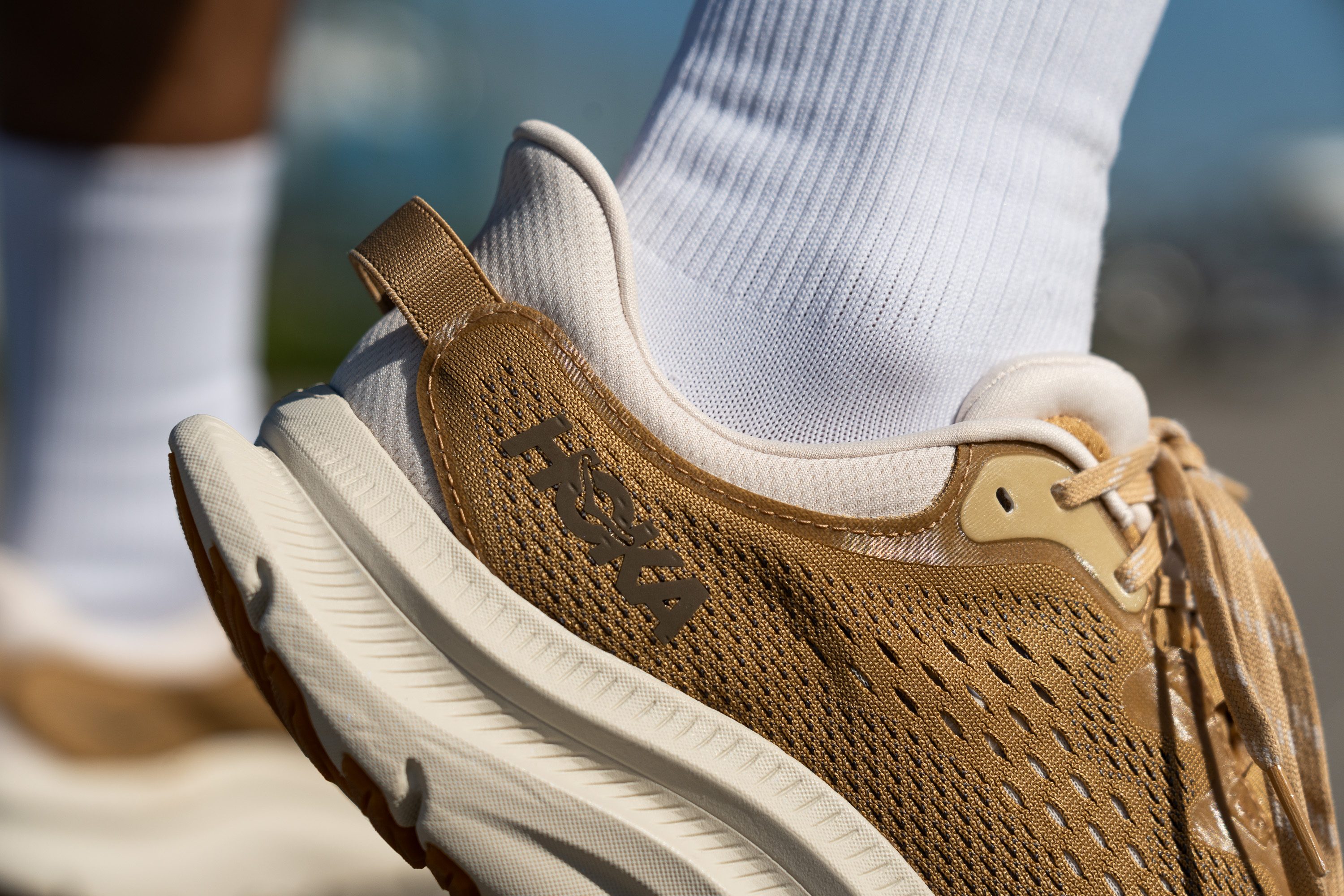
| Hoka Kawana 2 | Finger loop |

